I brought a friend from China, Leiyun, to the Donggongon tamu this morning. It had rained earlier so the market was cool. Leiyun enjoyed discovering all the exotic vegs and fruits, most of which she has never seen before. And neither have I. The tamu is a great place to take pictures and I just wish I could do justice to the place, but unfortunately it was dark and I still haven't learnt to use all the modes in my camera.
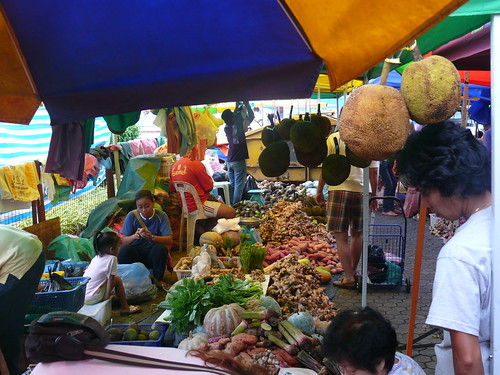
All kinds of tubers, roots and veg laid on the floor. Prices are much lower than the regular markets.
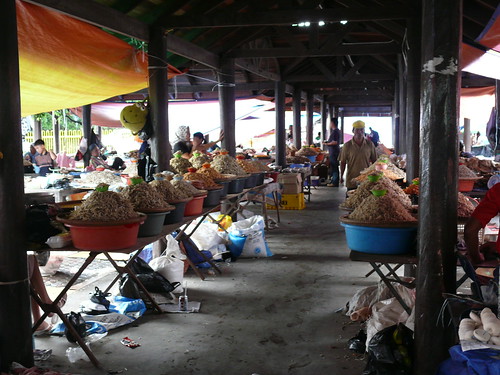
This section sells all kinds of dried fish, squid, shrimps and other dried seafood.
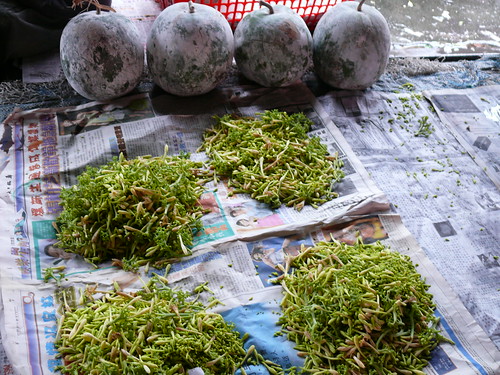
Front: Papaya flowers. Back: Winter melon.
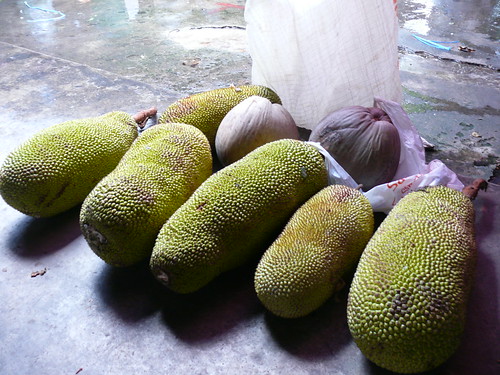
Jackfruits.
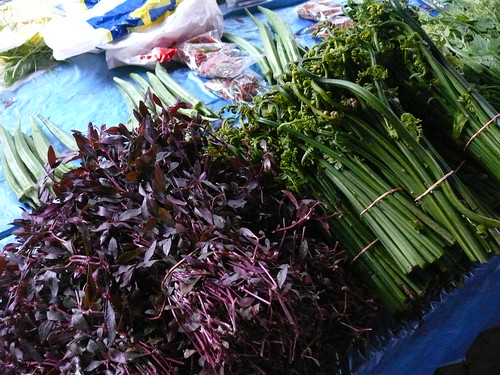
Wild ferns; good if you know how to cook them. I don't.

Fish traps, fruit baskets and other hand-made bamboo craft. I bought a beautiful shopping basket for only RM16 (US$4.70)
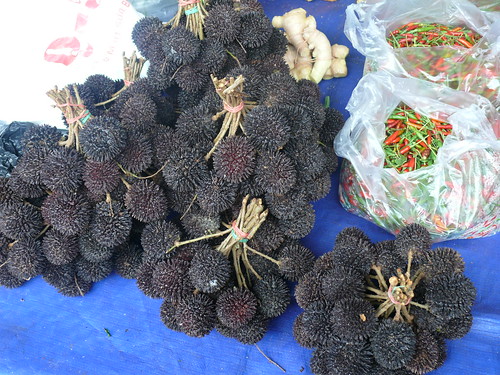
Wild rambutans. These are usually soft and sour.
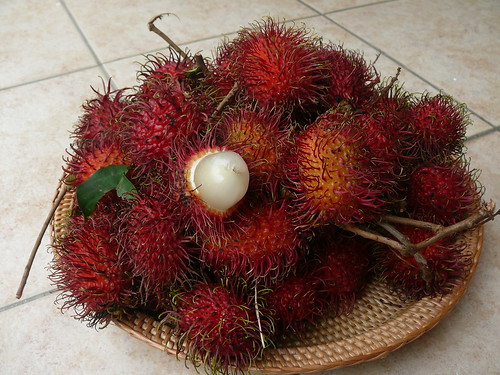
Now these are called rambutan kelapa or coconut rambutan. Three things you want in rambutans: the flesh should come off the inner seed, they should be sweet, and they mustn't be dry. My China friend is surprised by the sweetness and crunchiness of these rambutans as the ones she has eaten in China were anything but. Of course these are good. They were probably just plucked off the tree in the early morning.
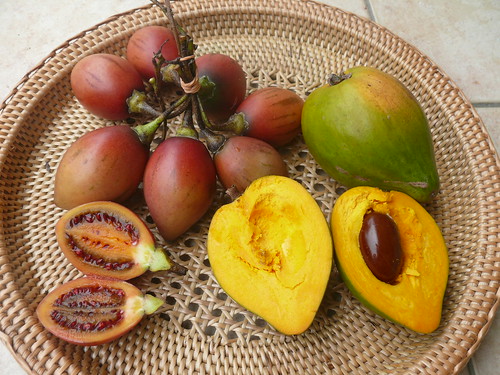
That reddish fruit on the left is called buah hati (heart/liver fruit, prob. because of the color) while the one on the right is buah keju (cheese fruit, maybe because the texture is unusual, like cream cheese). The cheese fruit is tasteless, odorless, creamy and leaves a slightly bitter taste. The heart fruit is good: sweet, sour and then, at the end a slightly salty umami taste, with a slight guava flavor.
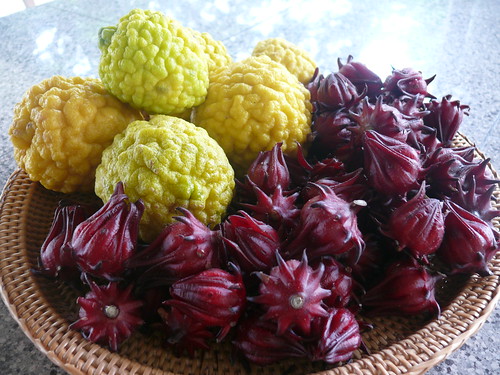
That's kaffir lime-lemon and the reddish fruit is called ribena so people boil it to make a clone Ribena drink. The real Ribena is supposedly made from blackcurrant although now that those two Kiwi schoolgirls have tested and found the drink to not have any vitamin C, it makes you wonder whether it is coloring and sugar all along.
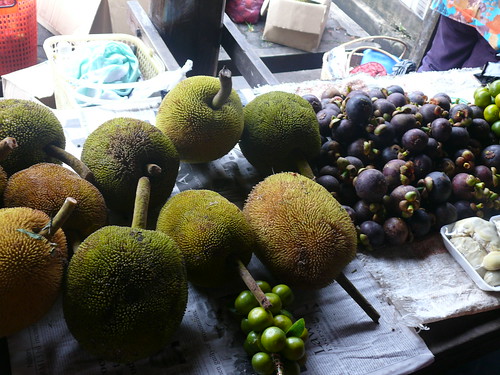
The fruit on the left is found only on Borneo Island. Called tarap, it smells like garbage but the pulpy flesh inside is sweet. Yummy. We get requests from friends and relatives to smuggle the unripe tarap (no smell when unripe) whenever we go to Singapore. That's mangosteen on the right. Another yummy tropical fruit. Tropical fruits lack 'finesse' and looks compared to temperate fruits but they win in intensity and variety of flavors.

These are wild durians from the jungle. They all have about the same slightly burnt durian flavor. The dark orange one can sometimes taste of peanut butter. Of the three types here, I found the medium orange type to be the best. As it was about to rain, I didn't have time to buy my favorite wild durian which has a more distinct wild durian smell and taste, with thick flesh and small seeds, but you can read about it here. These wild durians are so creamy (many people are thrown off by not just the smell, but by the creamy texture as versus crunchy/soft texture of most fruits), two or three is enough to make you feel full. The dark orange one especially is so dense and thick it is like eating hardened cream. My friend from China found it "quite pleasant, not at all as bad as what people say about it."
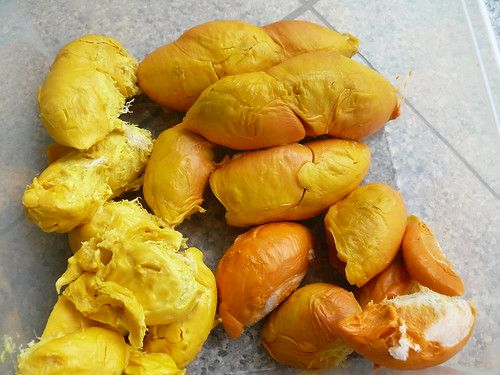
When I was eating these by myself this afternoon, I just praised God for giving us durians! Not exactly a beauty-contest winner (imagine the flesh in brown color--you know what I mean!) but it is absolutely delicious and lovers of this fruit would blow all their money just to eat it. Thank goodness durians are seasonal fruits or we'll all go broke.

So it's true then? Tarap (which I LOVE) is mainly found in Sabah? Was just having a chat about this today - again great timing that you brought this up. Great tasting fruit :)
ReplyDeleteYOU FOUND JUNGLE DURIANS AT THE MARKET!!!!!!
ReplyDeleteAHHHHH
This is torturous! Didn't see any when I was back home.
Those are by far the best type of durian ive tried!
Oh My God! The durian just kill me!!!! I think the sabah have different type of durian than the West Malaysia...I wish one day I will have the chance to sample the Sabah Durian...it look so attractive!!
ReplyDeleteLY.Tai
Just had durian last night. :D Love the stuff, I think have opened 10 of them in the past two days. Shared some with two friends and then with my dad.
ReplyDeleteNot such a big fan of the orange durians. Taste like plastic to me! Also I tend to favour slightly bitter.
Shan: don't take my word for it, but i'm 99.99% sure it's only found on Borneo Island. Do u eat the seeds? they're great boiled, then roasted n salted.
ReplyDeleteyi: durian season again! wish u were home:( Bobby says hi; complimented u. then charged me RM60 for a haircut tt none of d boys have noticed so far.esp d big boy.
coketai: is tt 'cocktail' in some kind of code??:) ya, i've always to know if its true there's a purple durian in West M. Yes, Sabah durian rocks because they are not fully hybridised n cultivated. hey, ur blog's interesting--will visit again when i have more time.u must've found mine when sreaching on Shanghainese food?
b: someone gave me REALLY good (thick-flesh, strong flavor) durian tt she bought on tt new highway tt leads to Donggongon. Plastic???no way. try the wild durians tt are very round, very green with very thin long thorns n come back to me.
Tarap is definitely not found in West Malaysia! My second daughter loves it and FIL says it's only found in Sabah!
ReplyDeleteWant to eat tarap? Come and visit me says FIL. Great fruit - taste like a mild flavored durian.
Buah hati is called Tamarillo in English. I love them. I normally scoop out the flesh and eat with sugar. In Indonesia, they are used to make syrup too, very refreshing.
ReplyDeleteThe green fern in your fern picture is known in Hawaii as "warabi" (I believe its a japanese word). We eat it in salads. I'd be happy to share a recipe or two.
ReplyDelete